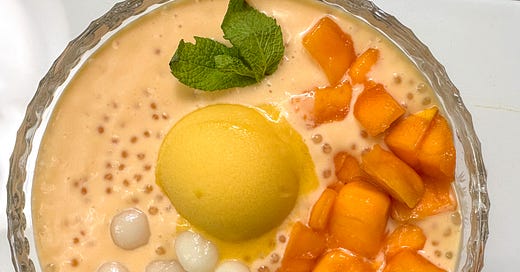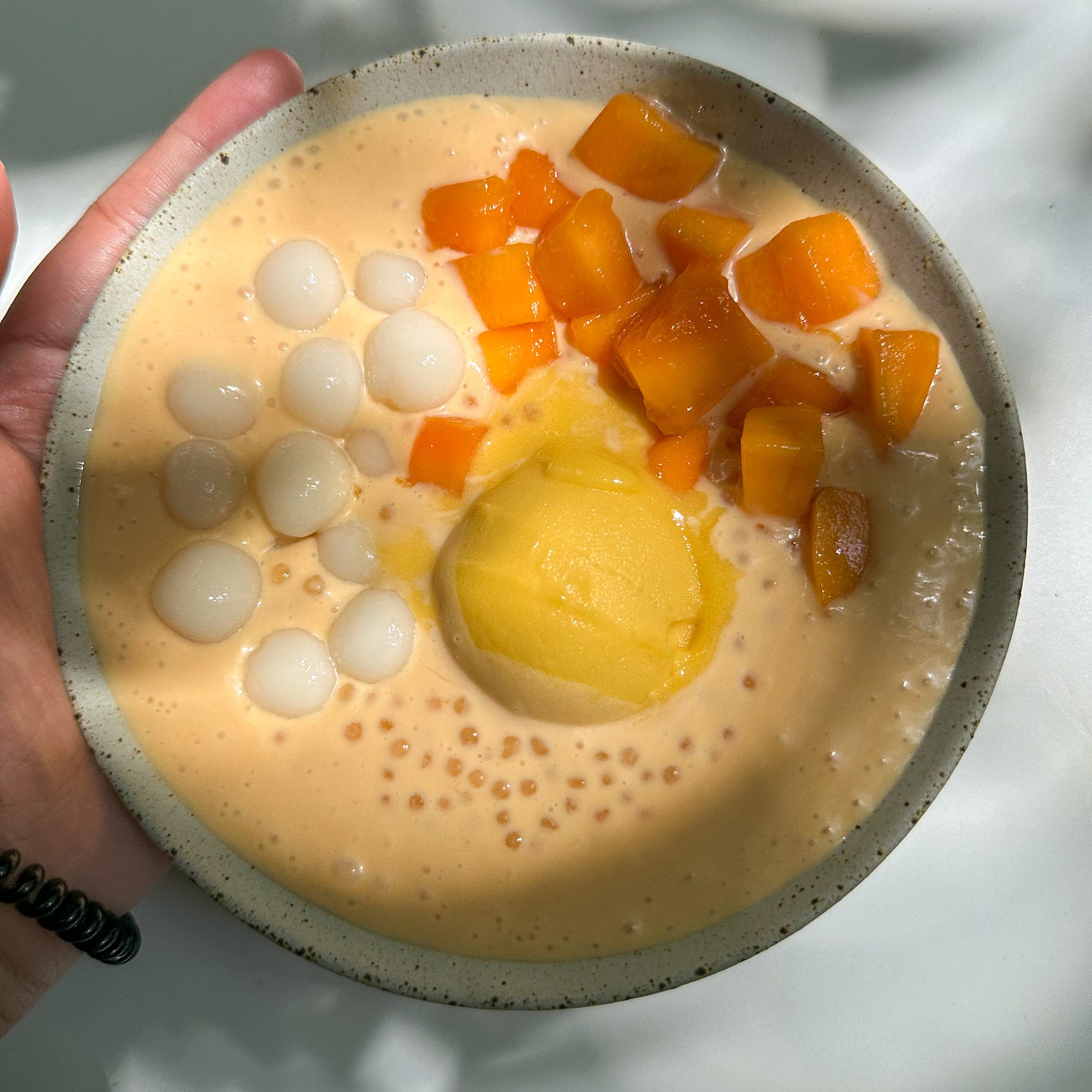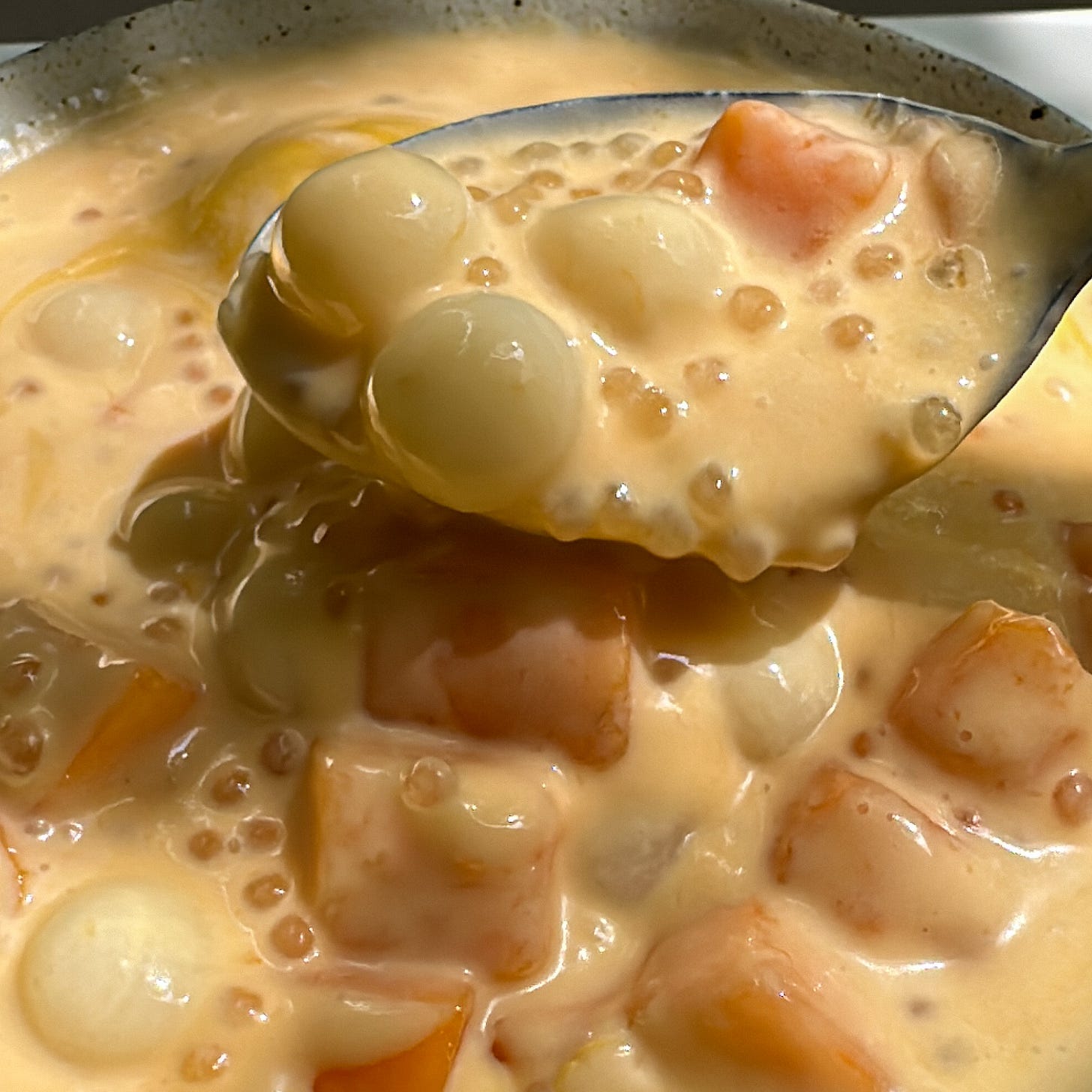Hi! Peak summer has arrived - it has been quite warm and humid in Berlin in the last few days and uncharacteristically, I’m making a dessert recipe!
What motivates a recipe? Most of the time, I try to plan my content around certain pantry ingredients or flavor profiles. Occasionally, it’s more random: just the excitement over a specific produce. Two weeks ago, I was wandering in Berlin’s Viet-Town Dongxuan Center and made a stop at a Pakistani (or Indian) shop. I discovered this place two or three years ago, and they carry imported tropical fruits, including rambutan, mangosteen, and jackfruit. The Pakistani mangoes are the best I’ve found in Berlin so far. Stepping into the store, with the hot air infused with the fragrance of ripe mangoes, I knew I wanted to make Mango Sago.
What is Mango Sago?
Mango sago (芒果西米露) is a chilled pudding mixed with tapioca pearls. This modern dessert from Hong Kong is believed to be the invention of the restaurant Lei Garden in the 1980s when they opened their new branch in Singapore. To appeal to local eaters, they included tropical fruits and sago1. This Mango Pomelo Sago dessert, with a poetic name “杨枝甘露” (means the sweet dew of will branch) then became sensation in Hong Kong, praised by the writer Au Yeung Ying Chai as a creative post-modern fusion dessert.2 Sago desserts common in other Southeast Asian regions, as seen in Filipino taho and Malaysian Sago Gula Melaka. The word sago originally comes from traditional sago pearls made from sago palm, but most store-bought pearls labeled as sago (西米) are made from tapioca starch (also called cassava sago, here’s more to the difference of these two starch pearls).
In the early 2010s, when I was in college, the famed HK chain Honeymoon Dessert (满记甜品) was rapidly expanding in mainland China. They served a variety of mango and durian desserts, along with sweet soups and puddings. Their signature dish is undoubtedly Mango Sago. Both my mom and I became big fans once we were introduced to it. Whenever she visited me in Chengdu during the weekends, we would treat ourselves to these for our mother-daughter time. I liked to order mango sago with pomelo (杨枝甘露) or with mini sticky rice balls, like mini Tangyuan (多芒小丸子).
I have tried to recreate this dish a few times after moving to Germany, and realised the key to this relatively straightforward recipe is to get high-quality, tasty mangoes. It might be given in tropical countries when in season, but here it can be an ordeal. But once I made this dessert with the Pakistani mangoes I got, it reminded me why some Chinese or Asian desserts appeal to me: the natural sweetness from the fruit and an interplay of textures—the soft mango, chewy sticky rice balls, and pillowy tapioca pearls.
Since pomelo is out of season, I decided to recreate the sticky rice ball version. Of course, you can also just make the basic mango sago part.
The recipe
Servings: 2 big portions or 4 small portions
Ingredients
For the sticky rice balls:
100 g sticky rice flour
75 g hot water, add more if needed
For the mango sago:
2 medium-sized ripe mangoes (weigh 570 g/1.2 lbs)
40 g / 1.5 oz dried tapioca pearls
300 ml / 1.25 cups milk of your choice (I used 100 ml coconut milk + 200 ml regular milk)
1-2 tbsp sweetened condensed milk
mango sorbet or other ice cream (optional)
mint (optional)
Instructions
To make the sticky rice balls: Add sticky rice flour to a bowl, gradually add hot water, and mix with chopsticks to form small pieces. Then knead with your hands to form a dough, adding more water if needed. The dough should be malleable but not sticky. Divide the dough into four equal pieces, roll each piece into a long log, and cut into small pieces. Then roll into 1-1.5 cm () diameter balls (slightly bigger than a pea).
Cook the mini sticky rice balls: Bring a pot of water to a boil, cook about 10-15 balls for about 5-7 minutes until floating, then transfer to a bowl of iced water before serving. Store the rest in the freezer.
To cook the tapioca pearls: Bring a pot of water to a boil, cook over medium heat for about 10-12 minutes, or according to the package instructions, until most of the pearls are transparent with a white dot in the middle. Turn off the heat, cover with a lid, and let sit for another 10 minutes until the pearls become completely transparent. Rinse under running cold water a few times and transfer to a bowl of iced water before serving.
To assemble the dessert: Peel and cut the mango into small pieces. Add most of the mango flesh to a measuring cup, reserving some good pieces for topping. Add milk of your choice and condensed milk, then blend with an immersion blender (or use a regular blender) until smooth. Divide into bowls or dessert glasses, and mix with the drained tapioca pearls. Chill before serving, or enjoy directly with the sticky rice balls, mango sorbet, and some crushed ice.
Tips for making the best Mango Sago
Mango: Imported mangoes can be quite pricey here, so if you don’t want to splurge on this dessert, you can substitute with frozen mango for the puree and only use fresh mango for the topping.
Tapioca pearls: You can find these white tapioca pearls in most Asian grocery stores or online. Go for the small ones. I first tried the bigger pearls, which were really hard to cook through. The starchy pearls will soak up water during cooking, so add enough water (the weight ratio of pearls to water should be at least 1:15). Some stores have big instant pearls which save cooking time.
Sticky rice balls: These are like mini Tangyuan and can be served cold or hot in Chinese desserts. Of course, you can find store-bought frozen ones. Sticky rice flour is a bit hard to work with; add hot water at 70-80ºC, or even a few tablespoons of boiling water first. If your dough becomes flaky, you can microwave it for 10-20 seconds.
Choice of milk: I mix regular full-fat milk with coconut milk as I don’t want the coconut flavor to overpower the whole dish, but you can use either, or plant-based milk. Traditionally this dessert uses a simple syrup as a base; for me, a spoonful of sweetened condensed milk is my shortcut. However, you can directly add 1-2 tsp of white sugar, adjust to taste if you don’t have condensed milk.
Lei Garden (利苑酒家)’s version of Mango Pomelo Sago uses Carabo mango from Phillipines, white pomelo from Thailand and grapefruit.
In Au Yeung Ying Chai ‘s food memoir about Hong Kong (《香港味道2》)









I love that mango place! I always make a trip through there when I’m at Dong Xuan Center to see what they have, and I make a special trip when it’s honey mango season.